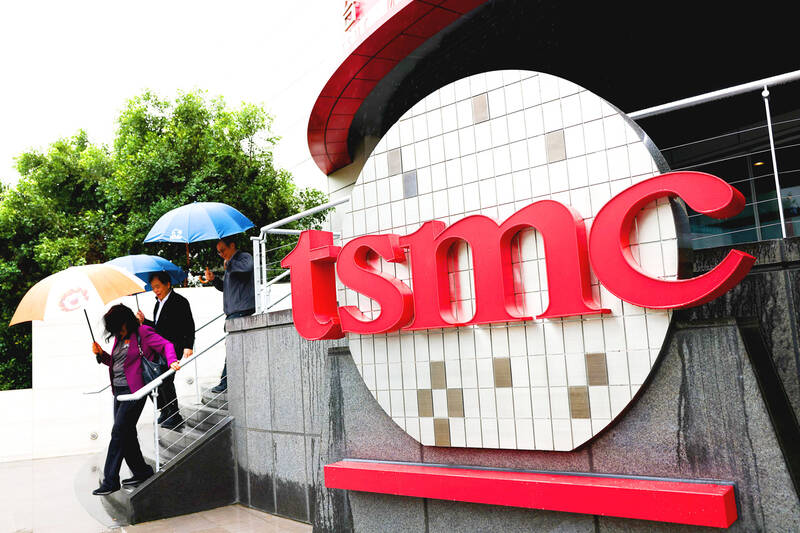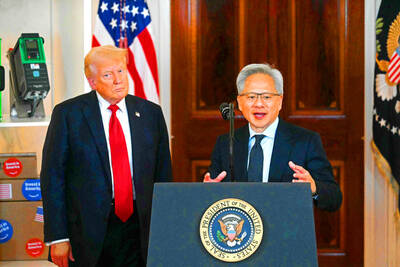With Taiwan Semiconductor Manufacturing Co (TSMC, 台積電) pouring large funds into Arizona, the US is expected to see an improvement in its status to become the second-largest maker of advanced semiconductors in 2027, Taipei-based market researcher TrendForce Corp (集邦科技) said in a report last week.
TrendForce estimates the US would account for a 21 percent share in the global advanced integrated circuit (IC) production market by 2027, sharply up from the current 9 percent, as TSMC is investing US$65 billion to build three wafer fabs in Arizona, the report said.
TrendForce defined the advanced chipmaking processes as the 7-nanometer process or more sophisticated technologies.

Photo: I-Hwa CHENG / AFP
The 3nm process is the latest technology TSMC has launched, with mass production in Tainan, while the chipmaker is developing the more sophisticated 2nm and even 1.4nm processes.
For Taiwan, its share of advanced IC processes in the global market is expected to fall to 54 percent in 2027 from the current 71 percent, although the country would retain the number one spot in 2027, the report said.
South Korea is likely to see its market share fall to 9 percent in 2027 from the current 11 percent, with its ranking expected to fall to third place from the current second, it said.
TSMC is building two advanced fabs in Arizona.
The first is scheduled to start mass production using its 4nm process in early next year, while the second is slated to mass-produce wafers using the 3nm and 2nm processes in 2028.
The company also plans to build a third fab in Arizona using the 2nm process or more advanced technology, with production slated to start by the end of 2030.
Ray Yang (楊瑞臨), an international strategy development consulting director at the government-sponsored Industrial Technology Research Institute (ITRI, 工業技術研究院), said after US president-elect Donald Trump returns to the White House in January, the US government is expected to further push for “Made in America” initiatives by cutting business taxes and raising tariffs to build a more comprehensive semiconductor ecosystem.
According to a projection made by the Boston Consulting Group, the US would triple its domestic semiconductor manufacturing capacity in 2032 compared with 2022, when the CHIPS and Science Act went into effect.
The consulting firm also projected capital expenditure in semiconductors in the US would account for more than one-quarter, or 28 percent, of the global total between next year and 2032.

Taiwan Semiconductor Manufacturing Co (TSMC, 台積電) last week recorded an increase in the number of shareholders to the highest in almost eight months, despite its share price falling 3.38 percent from the previous week, Taiwan Stock Exchange data released on Saturday showed. As of Friday, TSMC had 1.88 million shareholders, the most since the week of April 25 and an increase of 31,870 from the previous week, the data showed. The number of shareholders jumped despite a drop of NT$50 (US$1.59), or 3.38 percent, in TSMC’s share price from a week earlier to NT$1,430, as investors took profits from their earlier gains

AI TALENT: No financial details were released about the deal, in which top Groq executives, including its CEO, would join Nvidia to help advance the technology Nvidia Corp has agreed to a licensing deal with artificial intelligence (AI) start-up Groq, furthering its investments in companies connected to the AI boom and gaining the right to add a new type of technology to its products. The world’s largest publicly traded company has paid for the right to use Groq’s technology and is to integrate its chip design into future products. Some of the start-up’s executives are leaving to join Nvidia to help with that effort, the companies said. Groq would continue as an independent company with a new chief executive, it said on Wednesday in a post on its Web

CHINA RIVAL: The chips are positioned to compete with Nvidia’s Hopper and Blackwell products and would enable clusters connecting more than 100,000 chips Moore Threads Technology Co (摩爾線程) introduced a new generation of chips aimed at reducing artificial intelligence (AI) developers’ dependence on Nvidia Corp’s hardware, just weeks after pulling off one of the most successful Chinese initial public offerings (IPOs) in years. “These products will significantly enhance world-class computing speed and capabilities that all developers aspire to,” Moore Threads CEO Zhang Jianzhong (張建中), a former Nvidia executive, said on Saturday at a company event in Beijing. “We hope they can meet the needs of more developers in China so that you no longer need to wait for advanced foreign products.” Chinese chipmakers are in

POLICY REVERSAL: The decision to allow sales of Nvidia’s H200 chips to China came after years of tightening controls and has drawn objections among some Republicans US House Republicans are calling for arms-sale-style congressional oversight of artificial intelligence (AI) chip exports as US President Donald Trump’s administration moves to approve licenses for Nvidia Corp to ship its H200 processor to China. US Representative Brian Mast, the Republican chairman of the US House Committee on Foreign Affairs, which oversees export controls, on Friday introduced a bill dubbed the AI Overwatch Act that would require the US Congress to be notified of AI chips sales to adversaries. Any processors equal to or higher in capabilities than Nvidia’s H20 would be subject to oversight, the draft bill says. Lawmakers would have